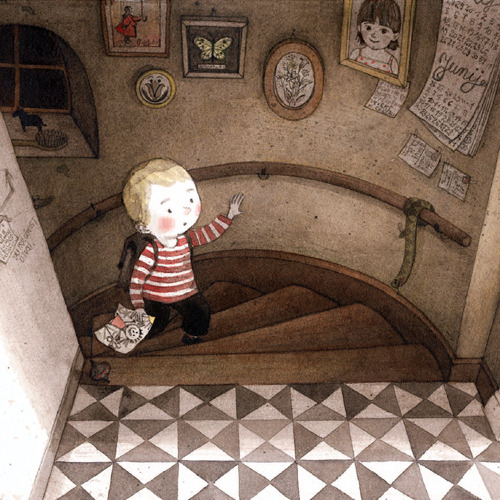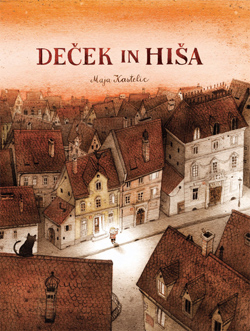< Back to posts
Maja Kastelic
Slovenia

Maja Kastelic was born in Slovenia, where she studied painting, philosophy and the theory of visual arts. She worked for several years as a retouching artist restoring frescos, before starting her career in children’s publishing. Maja has received a White Ravens Award and has been selected for the Bologna Illustrators Exhibition.
In this post, Maja talks about her debut picturebook, ‘Deček in Hiša’ (A Boy and a House). This beautifully illustrated wordless story is published in Slovenia by Mladinska knjiga, and is a homage to children’s literature and illustration.
Maja: ‘If I create from the heart, nearly everything works; if from the head, almost nothing.’
—Marc Chagall
‘A Boy and a House’ is a silent book about a little boy’s morning wandering, and also, or even more, a story about going up and following the light, about curiosity and daring, getting lost and finding, friendship, secrets, and also about hoping for and believing in happy endings. I also wished to make it as a homage to literature, illustration, and to the nostalgic beauty of old times and timeless things.
It was my first picturebook and it took me two years to finish it. Its making was full of everything – from enthusiasm to despair, paralysing uncertainties and little miracles on a small scale that seemed the world to me. A lot about the book changed while working on it, but the main idea remained the same: I wanted to make a book I’d give to a dear friend.
I studied painting while working as a fresco retoucher, but I’ve loved books and admired illustration for as long as I can remember. I’d been wishing I could somehow work in illustration for many years (and through two pregnancies), but there was never enough time, or the time wasn’t right, or I just didn’t know how to do it properly. So I just kept on daydreaming till I finally decided to enter the Slovenian Biennial of Illustration.
I’d never worked on a book project before, so I had to come up with my own story. Sketches of a boy I made some time earlier made me think about the need to seek the light and the effort we make to rise – and how we must believe in finding beauty. So I did three illustrations of a boy following a light through a mysterious old house. The illustrations were awarded in the Slovenian Biennial of Illustration, which encouraged me to make a storyboard and send it to Mladinska knjiga, the main publishing house in Slovenia. There were no words, at first because I just didn’t think about it, and later as a decision: wordless books are so universal and accessible, but their capacity to adapt to the reader’s perspective also makes them unique and personal.
The first version goes like this: A boy walks to school in the early morning when it’s still dark, but stops at the open doors of a lighted house. There is a cat who leads the boy through the labyrinth of rooms and staircases until they arrive on the roof to find the spectacular view of a brand new day. For me, it was primarily a metaphor about daring to set out into the unknown and pursuing what you think is good. However, the end seemed too open and not satisfactory enough for the reader, and there were also a few flaws within the logic of the narrative – like who is turning on the lights and if anybody lives in the house – so my editors wisely thought we should add some content and come up with a different ending.
Many notes, meetings and storyboard sketches later, we let the boy find drawings on the floor of the house, had him collect them while following the cat to the attic, and added a girl making paper planes which they release over the town together. This added much to the book and the metaphor was even better now: one of friendship and finding a way to one another.
The next thing was to define the look of the book – the appearance and the atmosphere. It felt right to place a story in an undefined, nostalgic past; I wanted to give it a sense of some childhood memory of discovery and wonder.
I filled up the scenography with my belongings and hints of what I admire. This was partly just putting in things I look at all the time, but I also imagined the house as a space which contained my thoughts, memories and ideas. It was very personal to me, but I also wanted it to be meaningful in some general sense as well – as a tribute to culture and playfulness, and to literature and the beauty found in little things. So there’s Grimm and Andersen Streets, proverbs and quotations on the fronts of buildings and walls (like Bucay’s ‘Let it go, let life surprise you’), real books, some playing cards, Ghibli’s soot gremlin, and framed illustrations by the artists I admire on the wall of the hallway – and also my own illustrations (two self-portraits), the names of my sons and a note for the reader (from the housekeeper, Maja), my porcelain ware, our gramophone and the wooden stairs from our house.
One of the most important parts of the narrative and of the atmosphere was the light: the chiaroscuro to create the tension and cocoon-like roundness of the space. I sketched a number of old houses and their interiors (I looked at photographs of old Slovenian town houses). I like their grandness and elegance, but also their dusky mysteriousness.
Working on tonal sketches seemed very natural but I had no idea how to do the final artwork. So I did a number of technique experiments; I tried pencils, inks, gouache, acrylics, watercolour and all the combinations of the above you can imagine. It was quite a factual, probably too objective way to handle the process, and I felt very stressed – till I finally realised I had to stop acting like a catalogue, and just come up with something that would be so immanently mine that it could hold the whole process together and allow me to play.
I later found Chagall’s famous quotation about how nearly everything works when you create from the heart and it proved true so many times later on in the process. I got another great piece of practical advice from my editor: to work on all the pieces at the same time in order to attain the wholeness and cohesion of the book. I was used to mixing pigments from my restoration work, and I like this alchemical witchery, so I took watercolour tubes and made my own dark mixture of umber, Van Dyke brown and Ivory black (it ended up as just another black, but the feeling was better). Another important factor was that I finally found a perfect watercolour paper that allowed many washes and layers without smearing.
I wanted the illustrations to convey the feeling of nostalgia we get when looking at old photographs. In fact, making them strongly resembled developing in the darkroom. Illustrations were done with single dark tone on very wet paper, and it was much like immersing the photographic paper into the developer so the image slowly emerged out of the whiteness. I was working in steps, constantly shifting from big-area colouring to finer details, gradual darkening. Adding depth and moulding objects was very sculptural, while the line work, patterns and inscriptions felt like delicate embroidery.
I painted all the scenes in black, and then added red iron oxide, burnt umber and raw sienna.
In contrast to the exciting and sometimes stressful first stage (developing a story, taking notes, looking for inspiration and experimenting with different media), I remember working on the final artwork as a very calm and natural process – as if I just let it all happen, without too much thinking or having an exact plan.
The process was very important for me – all of it. The discoveries and doubts, the practical knowledge and the failures, everything I’ve learned and the things I’ve forgotten... But I think the most valuable lesson for me, as an artist and a person, was becoming aware of the importance of following that inner voice, and sometimes, letting things come and go their own way.
Illustrations © Maja Kastelic.
Deček in Hiša /
A Boy and a House
Maja Kastelic
Mladinska knjiga, Slovenia, 2015
In this wordless story, a boy follows a cat into a mysterious house. In each room, he finds and collects pieces of paper and follows the cat all the way to the top of the house, where he discovers something surprising and wonderful.
This beautifully illustrated picturebook by Maja Kastelic has received numerous accolades including the Hinko Smrekar Award and a White Ravens Award.
- Slovenian: Mladinska knjiga
- German: Bohem Verlag
- French: Alice Éditions
- Italian: Casa Editrice Le Lettere
- Spanish: Ediciones Castillo (Macmillan)
- Swedish: Atrium Forlag
- Bulgarian: Emas Publishing
- Chinese (Simplified): The Petrel Publishing House




















